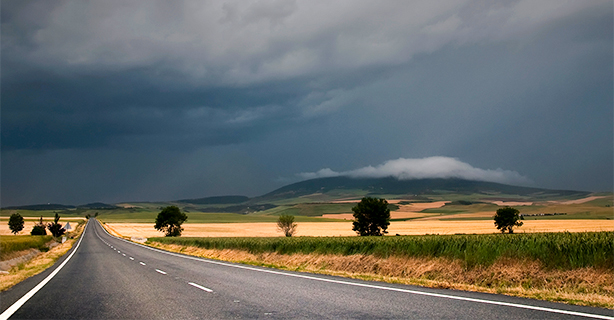Riding a motorcycle in the rain: How you can stay safe
0 min. read
If there's one thing motorcyclists love, it's the call of the open road—we get that. As motorcycle enthusiasts, we seek the joys of natural-world experiences and desire more than air-conditioned car rides while enduring—at best—the scent of cardboard pine trees dangling from rearview mirrors.
While we welcome nature's open-air sights and smells, there are some uncontrollable elements we face on the road. Rain is one of them. The undeniable scent of creeping rainfall usually reaches our nostrils just before it hits the face shield of our helmet, leaving us with a slight warning signal.
So, what's the best way to stay safe when riding a motorcycle in the rain?
Plan ahead
The best advice for staying safe when riding a motorcycle in the rain is to avoid it, if possible. If you're at home before it rains, don't head out as it starts to pour just to run an errand or two. The saying, "Be proactive, not reactive," is a good rule to live by—especially when your safety is at risk.
That said, if you're riding for longer trips, wet conditions can be an unavoidable factor you must face. When it comes, you need to be as prepared as possible—and driving with confidence is also imperative.
Check the forecast
Before you head out, check the weather. With access to technology and on-demand weather forecasting apps, there is no reason to hit the road without being informed.
Sure, weather predictions aren't always accurate. However, they can at least increase your chances of optimal preparation.
Choose the right gear
One of the first things you'll want to invest in as a motorcyclist, especially if you plan on taking longer road trips, is excellent rain gear—boots, pants, gloves, and a jacket. Some riders also have helmets with anti-fog systems.
Today, there are plenty of options when selecting excellent gear. Some factors to consider include wind, riding speed, flexibility for riding positions, and heat resistance. What you choose will depend on your personal preferences and your local weather conditions.
When shopping for rain gear, there are three core configurations:
A one-piece: This option is the smallest, lightest, and, typically, the most budget-friendly. The major perk of one-pieces is that there are few openings to let water in. The downside is that they can be tough to get in and out of—especially when worn over protective riding equipment.
A two-piece: This option includes a jacket and pants, which are relatively easy to put on and take off. Also, the jacket can be used when not on your motorcycle. The negative to this choice is that it can be bulkier to pack and increases the chance of getting wet—the area where your jacket meets your pants can give water a chance to soak your clothes.
Two-piece with bib pants: A two-piece outfit with bib pants resembles overalls. This design helps eliminate that water entry spot (where the jacket meets your pants) and only slightly increases the packing size.
The best option for you will depend on how often you ride in the rain, your budget, and your style.
Outfit your motorcycle
It isn't just yourself you must prepare for rainy days—you also need to consider your bike.
If you live in an area with a rainy season, it's recommended that you complete a thorough check-up of your motorcycle:
How are your brake pads?
Do you need some higher-traction tires?
Have you recently checked your headlights?
Rain will reduce visibility, so ensure all lights work as expected—including your indicators and brake lights.
To protect the longevity of your motorcycle, you'll also want to keep the chain well-lubricated. Lube your motorcycle chain anywhere between 300 to 600 miles—unless your motorcycle is exposed to moderate-heavy rain. In this case, you should lube your chain after any water exposure.
The same rules apply if your motorcycle was left in a parking lot uncovered during a rainfall—or if you're visiting a coastal area that exposes your bike to salty air. If you plan to park your bike outside, pack a waterproof cover. This small investment will help reduce rusting, increasing the longevity of your bike and the safety of your next ride.
Consider the terrain
The terrain you're on will determine how you ride—especially during rain.
If you're riding a motorcycle in the rain across wide-open flatlands, you may be able to spot a storm in the distance, providing you with an opportunity to find a rest stop. However, that's not always possible.
When riding in the mountains, rain and microclimates can surface with little to no warning. In these cases, don't panic. Ride safely until you find an appropriate spot to stop and put on rain gear or wait out the storm.
Stay calm
Continuously seek safe driving knowledge so that you're prepared when riding a motorcycle in the rain. The more experienced and mentally prepared you are, the calmer and safer you'll remain. For example, tires on wet pavement have much less traction, so keep an increased braking distance at all times.
As the rain falls, gently reduce your speed and remain smooth at the controls.
To keep peace of mind every time you're out riding, invest in good tires and regular tire maintenance.
Do you have any questions about your motorcycle insurance coverage? If you prefer speaking to our team directly, don't hesitate to contact us—we're here to help.
The general information in this blog is for informational or entertainment purposes only. View our blog disclaimer.
*Data accuracy is subject to this article's publication date.







